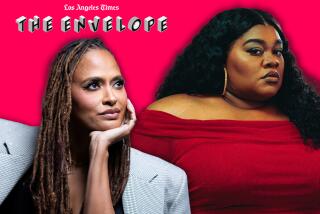Radha Blank films a ‘Version’ close to herself, quiet contemplation and all
- Share via
The road to Radha Blank’s intimate and hilariously autobiographical debut film, “The Forty-Year-Old Version,” began with her losing her first screenwriting job.
Blank puts it even more bluntly. “One of my roles as an artist is to demystify things,” she says. “I got fired off that job. And I just wanted to create something I couldn’t get fired from.”
A longtime struggling playwright, Blank developed her life story into a script about a 40-something Harlem-based theater artist who finds an unexpected outlet as an amateur rapper. “It was not my initial intention to make it as a film,” she says. Blank originally “took a note from my millennial brothers and sisters” and conceived it as a DIY web series.
But after further developing the project at the Sundance Institute’s Screenwriters and Directors Labs, Blank turned it into a striking two-hour movie, shot on 35-millimeter black and white film, in which the writer-director also stars as a character named Radha. (She has since won Sundance’s directing award and its 2020 Vanguard Award for “The Forty-Year-Old Version.”)
“It was a long journey to 35-millimeter, black and white film,” she says. “It pulled me back towards being an artist and an auteur. It wasn’t a process of elimination. I really do feel that it evolved into this thing.”
Shooting on black and white film was obviously not a commercial calculation. “I thought black and white would make it more sophisticated, more vulnerable,” Blank says. She mentions the photography of Roy DeCarava and Carrie Mae Weems, “people who are capturing Black lives in black and white, but then all these sumptuous shades of gray show up.”
Though she had the landscapes of New York City at her disposal, she says she realized she wasn’t going to match the aesthetic delights of, say, Woody Allen’s “Manhattan.” At any rate, she hadn’t conceived “Version” as a valentine to the city. “Sometimes the movie is a love letter. Sometimes it’s a Dear John letter. My love affair with the city is troubled.”
Instead, she decided, “I’m going to make the people and their skin tones the aesthetic. I see Peter Kim, who plays Archie, representing my head. And Oswin Benjamin, who plays D, representing my heart. There’s only one scene where we’re all together. And it was important to me that all of our skin — each one of us having different skin tones — that it was popping.”
Though Blank is conversant in film history, she bristles slightly at the mention of Spike Lee’s influence. (Recently, she was a writer and producer on Lee’s Netflix update of “She’s Gotta Have It.”) “I get it,” she says. “I’m Black. There’s another Black filmmaker who made a black and white film. Of course he’s influenced me. But I’ve studied film. I’m a cinephile raised by cinephiles.” In situating her own work, she mentions directors as varied as Bill Gunn, Christopher Guest, John Cassavetes, Kathleen Collins and Billy Wilder.
Like some of these filmmakers, Blank took on the added challenge of directing her own performance. She says that the key was not taking herself seriously. “I just left myself open to falling on my face and not worrying about my appearance. As a person who has struggled with my weight for many years, it was very liberating to say, ‘This is in service of the character.’ I had to divorce myself from the person who’s always overthinking [things], and let the character take over.”
Blank says she does recognize the Radha onscreen as a version of herself. “I’m shooting in my real Harlem apartment. That is my real big brother. Some of those are my real friends. I did not choke a theater producer, but I have wanted to.”
She wanted the camera to match this documentary quality, to capture “anything and everything that might be gold. It’s not always a steady shot. Some things might be out of focus. The boom might be in the shot. It’s about the immediacy of it.”
“The Forty-Year-Old Version” represents Blank’s attempt to make space for lived experience. “The Black people in my film don’t wake up tap-dancing and rapping,” she says. “They contemplate, too. There are mundane moments when they have to look out the window and look at themselves in the mirror.”
She mentions the recent film “A Ghost Story,” where a mourning Rooney Mara eats an entire pie — in silence, in real time. “I want that level of contemplation, mundanity and silence for Black characters.”
Shortly before this interview, “The Forty-Year-Old Version” was named one of 2020’s top films by the New Yorker and both New York Times critics, a development that Blank found validating. And, of course, it sets up heightened expectations for whatever she does next.
“For many years, my identity was about being a struggling artist,” she says. “With this film, I had an internal cheat sheet.” She says that she doesn’t yet know her next project, but don’t expect a “Version” sequel. “The fact that I might do a story that has nothing to do with me ... I’m excited to be in that place.”
More to Read
Sign up for The Envelope
Get exclusive awards season news, in-depth interviews and columnist Glenn Whipp’s must-read analysis straight to your inbox.
You may occasionally receive promotional content from the Los Angeles Times.






